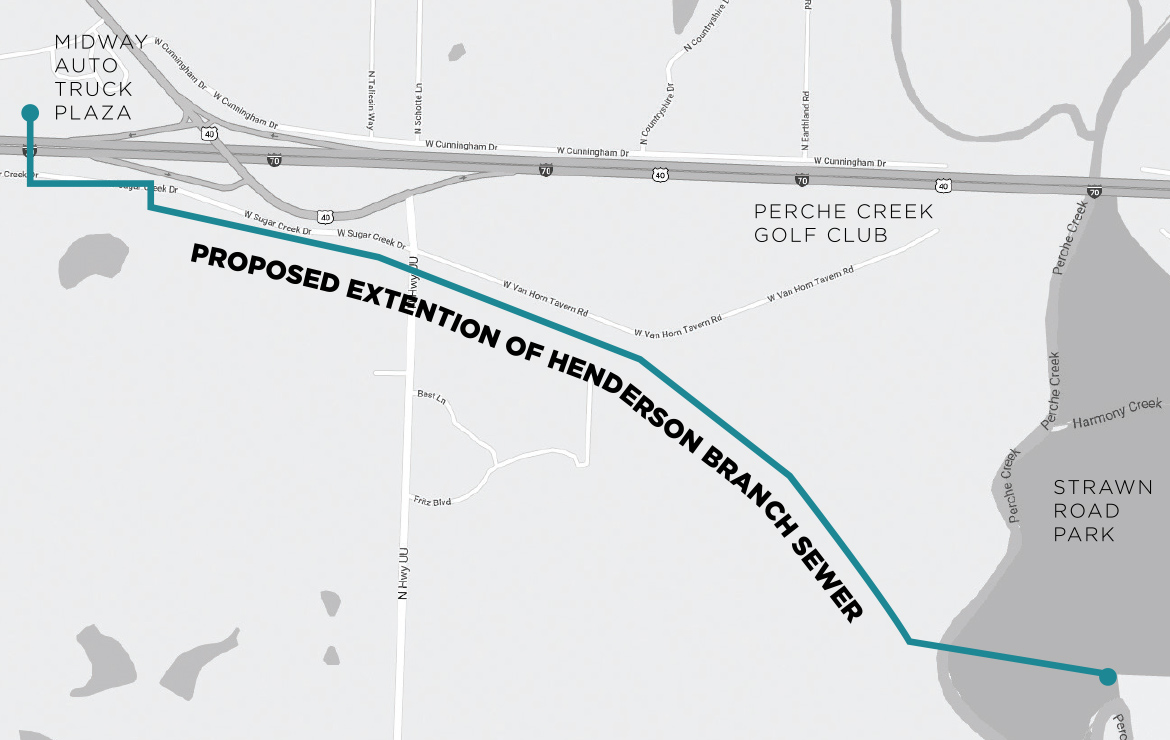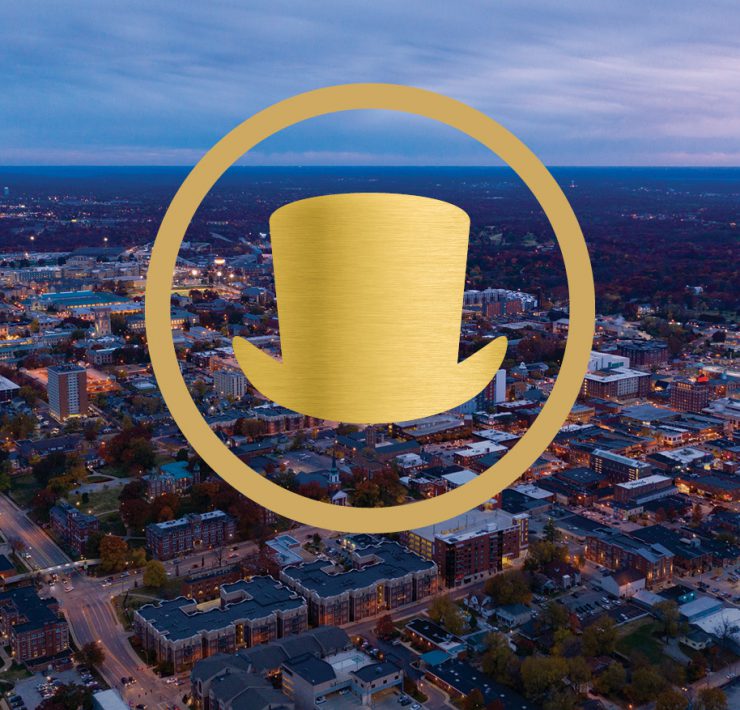In Focus: What Happens Now?

A contentious debate over sewers has led to a stink among voters.
In 2013, Columbia voters approved a $32 million bond issue that was to be allocated towards the city’s sewer systems. Within the bond issue, the city identified 30 sewer projects that it felt needed to be worked on. One of those projects was the Henderson Branch project, a now controversial project that would extend a sewer line into the Henderson Branch watershed and annex an area with large employers including MidwayUSA and the Midway Truck and Travel Plaza.
Five years after it was approved, the project has continued to be a subject of debate as city council has repeatedly rejected the project, most recently in a 4–3 vote from September.
Some council members and city officials have argued that the project is not feasible or necessary, while many people in Columbia say the council’s decision to deny a voter-approved project significantly erodes voter trust in the city government.
The Henderson Branch project would have included extending more than 8,600 feet of sewer line to serve the 1,300-acre Henderson Branch watershed and annexed properties owned by prominent business owners Larry Potterfield and Joe Bechtold. As it stands now, the Henderson Branch project is listed as “cancelled” by the city.
Proponents of the project worry that the council’s decision could prove to be damaging to the city.
HISTORY OF THE PROJECT
Former city manager Bill Watkins said the idea for the Henderson Branch project has been identified for over a decade. In fact, the city’s Sewer Master Plan, a report created by engineering firm Black & Veatch in 2004 for the city to “meet the needs and demands of your growing community and surrounding area through year 2030,” listed the Henderson Branch outfall in its original draft. Watkins served as Columbia’s assistant city manager from 1995 to 2006 and was appointed to city manager in January 2006. He announced his retirement in October 2010.
During his tenure in city government, Watkins says that city council had a policy that emphasized the need to clean up the streams that flowed through the city. He says the city looked at Perche Creek, a creek on the west side of the city, and also did some work on Bear Creek.
“The Henderson Branch is sitting there with what we thought and I still believe are some lagoons that really aren’t up to snuff,” Watkins says. “My personal opinion is, and I think most people would agree, if you can get sanitary sewage into the city system where it is monitored 24 hours a day, that is much more satisfactory than some of the lagoon systems that were built many, many years ago and have histories of overflow.”
Watkins says fixing this system and creating the Henderson Branch project was a “fairly obvious next step,” and the city put the project up to the Capital Improvements Plan. However, Watkins says, the city realized they didn’t have money to fund the project until the next sewer bond ballot, which was in 2013.
He says the city started putting the contents of that ballot together before he retired and that he had talked to Potterfield and Bechtold, who both expressed interest and willingness to become involved. On August 5, 2013, city council approved the calling of a special election related to the issuance of $32,340,000 in sewer system revenue bonds to be placed on the ballot.
Deputy City Manager John Glascock says that a group of private citizens, organized under the name “Citizens for Columbia’s Future,” promoted the sewer bond issue. City staff would accompany the citizen group when requested to provide information on the needs of the sewer system and the projects proposed, but Glascock says that city involvement was limited to just providing information.
Glascock says that, although the Henderson Branch project was included as one of the projects in the bond issue, the ballot did not include references to any specific project. Instead, the ballot that voters received in November read, “for the purpose of constructing, improving, repairing, rehabilitating, replacing, equipping, expanding, and extending the city-owned sewerage system.”
On August 5, 2013, City Council received a supplemental memo that identified specific projects that were to be funded by the sewer bonds as well as more information on each project. The Henderson Branch project was one of those projects.
On November 5, 2013, voters in Columbia approved the bond issue and subsequently all of the projects that were to be funded by the issue including the Henderson Branch project.
David Nivens, chairman of the Columbia Chamber of Commerce, says the project was not originally spurred by simply trying to incorporate the area into Columbia to receive tax revenues from large businesses like MidwayUSA and the Midway Truck Stop.
Instead, Nivens says, the original iteration of the project focused on addressing environmental concerns surrounding how sewage was being handled in the area.
The Henderson Branch project was initially allocated $2.6 million of the approved bond issue. However, more recently, Glascock says the engineer hired to design the project estimated the total cost to be about $4.3 million.
Nivens argues that because the city has not put out a request for proposal for the project, this estimate is only guesswork.
“I mean at the end of the day, it doesn’t matter what somebody thinks it might take to get it done. You don’t know what that number is until you actually ask somebody to give it to you,” he says.
Despite approving the project in 2017 by a vote of 5–2, city council members eventually denied the project on September 4, 2018, by a 4–3 vote.

GOOD FOR THE CITY
According to a memo given to the council in 2016, it is estimated that the city would have received approximately $479,512 in tax revenue from the Henderson Branch project. The document, created with information provided by the businesses in the proposed annexation area and from the Boone County Assessor’s office, states that the city would have collected a total of $438,520 in sales tax, $18,217 in property tax, and $22,775 in gross receipts tax.
If the project was approved, $251,262 of the revenue would have been allocated to the city’s general fund and the remaining $228,250 would be allocated to special revenue funds.
Nivens says that even though he doesn’t think it’s likely the council will revisit the project, he thinks it’s good for the city.
“What are the benefits? Well, we would be incorporating into our city an overpass over a major highway, which I think has great value in and of itself,” Nivens says. “Second, you’ve got a major employer that’s located in that area that would immediately pull into our tax base all of the payroll, all of the sales tax, things that the City of Columbia is not currently getting by it being out in the county.”
Nivens says he and other Chamber of Commerce members saw the project as an opportunity to include great businesses into the community as it expands and grows.
Watkins says he still believes that the Henderson Branch project is a necessary and “good” project.
“I think it was needed for three reasons: One, from an environmental perspective, I think it was the right thing to do — it cleans up streams,” Watkins says. “Secondly, this was a kind of unique project because of the annexations that were associated with it. It was a deal that was going to bring a lot of money into the general fund. And thirdly, I think the tradition has been you do what you say you’re going to do.”
BAD BUSINESS DECISION
Fourth Ward Councilman Ian Thomas has consistently voted against the project when it’s been brought before council.
“In my opinion, construction of the Henderson Branch sewer extension at the present time would be a very bad business decision for the City of Columbia,” Thomas says. “While we would lose some money on the construction of the sewer itself, the much greater concern would be the 300-plus acres of new development west of the Perche Creek that would be triggered by the annexation process.”
Thomas says that taxpayers and ratepayers currently provide a $25,000 to $30,000 subsidy for every home built in Columbia because of what he describes as “grossly inadequate” development impact fees and connection charges, and he believes the natural barrier of Perche Creek would amplify those one-time expansion costs.
“As a steward of the taxpayers’ money, I believe it would be irresponsible to commit city taxpayers to these enormous costs before we conduct a growth impact study and implement appropriate development fees and connection charges,” he says.
He says that it would be disingenuous to argue that the revenues provided to the city by the project would pay for the upfront costs of infrastructure expansion because they’re needed for ongoing costs such as police, fire, and road maintenance.
“If we adopt adequate development impact fees and connection charges, I would reconsider my position on the Henderson Branch sewer,” he says.
2013 SEWER BOND PROJECTS
City Utilities Assistant Director David Sorrell just recently created a report that will be presented at the next council meeting. The report includes a list of all the projects included in the 2013 sewer bond issue as well as the amount spent to date, initial budget, and a status update on each project. Of the 30 projects listed in Sorrell’s report, only 14 are listed as complete.
“A lot of people will say, ‘Here it is five years later and you’re not done.’ While we have typically gone to bond issues about every five years, that doesn’t mean we always have, and that doesn’t mean you do all your bond issue projects within a five-year time frame either,” Sorrell says.
Sewer system revenue bonds work a lot like U.S. savings bonds with the idea being that when you buy a bond, you’re going to get a certain return on your investment, Sorrell explains. Investors buy the bonds from the city and then the city has to pay it back in principal and interest each year, similar to a mortgage.
“We can’t do a project unless we have the money sitting in the account to pay for it,” he says. “So, we can borrow those funds, do these projects and then all the current users of the system are paying for that project, but also all the new users are paying for that project with the bond issue. If you pay for it solely through rates, only the current users pay for it because you have to bill the money upfront.”
ERODING PUBLIC TRUST
Although some critics of the city have brought up the slow nature of completed projects, most have simply pointed to the fact that council has repeatedly denied a voter-approved project in the Henderson Branch project. In July, Nivens addressed the council with a prepared statement from the Chamber of Commerce that said it was concerned with the council’s lack of will to advance voter-approved projects forward and that the council had delayed certain projects that would advance the city.
“This has eroded the business community and the public’s trust that our elected officials will follow through with voter-approved projects,” the statement read.
Two years ago, Nivens says the chamber included in its local legislative agenda an item regarding holding city government accountable for following through on projects that have been voter-approved.
“We didn’t just decide to do that as an organization out of thin air,” Nivens says. “There’s kind of been a history of this over time, and we felt like it was important enough that somebody needs to be keeping an eye on these types of issues and making sure that our city government is following through on the projects that they are putting forward to vote in the community.”
Thomas says he agrees that Columbia would have a much better functioning local government if projects are properly vetted by the public before the vote and the City Council follows through, but he believes there wasn’t proper vetting for the 2013 ballot issue and the presentations that listed the Henderson Branch project were mostly made to the Chamber of Commerce an d not reported to regular citizens.
Where it stands right now, the Henderson Branch project is essentially dead. After the vote for the project was denied by city council, the Columbia Missourian reported that Larry Potterfield was threatening to move his company out of the area. Although there have been no recent claims by Potterfield that he plans to follow through on this, many in the community are concerned about what this vote could mean for the city.
Watkins says that if the city wants new businesses that pay taxes, it first has to have a population base, and if people can’t afford to live in the area, it’s going to be hard attracting new business.
“Who knows where we’ll be in five years,” Watkins says. “The things that people were concerned about are going to happen anyway, but the city isn’t going to be able to plan or regulate how the development happens.”
FUNDING AMOUNTS ASSOCIATED WITH THE SEWER EXTENSION
The Henderson Branch sewer extension’s budget was estimated at $4,655,644.
As of October 2018, only $260,770 was spent towards the sewer extension, which has been canceled.
The 2013 bond for the sewer extension raised $2,600,000 in funds.
If the businesses located at the Midway exit were annexed into Columbia, it was estimated that the city of Columbia would receive $438,520 in sales tax in a 2016 estimate.








